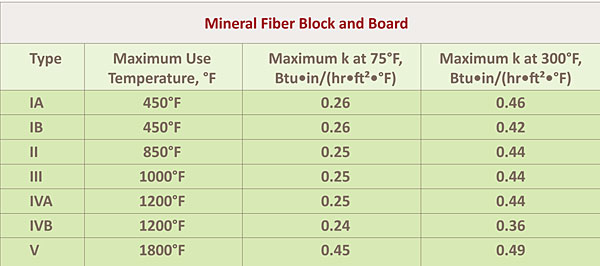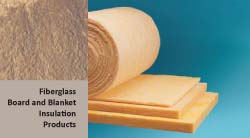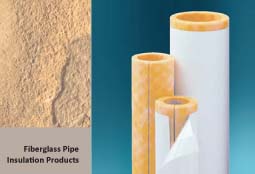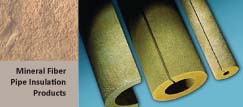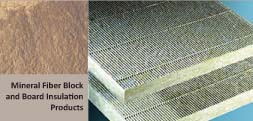Exploring Insulation Materials
Fibrous Insulations
Fibrous insulations are
composed of small-diameter fibers that finely divide the air space. The fibers
may be organic or inorganic and they are normally (but not always) held
together by a binder. Typical inorganic fibers include glass, rock wool, slag
wool, and alumina silica.
Mineral Fiber (Fiberglass
and Mineral Wool)
Mineral fiber insulations
are defined by ASTM as insulations composed principally of fibers manufactured
from rock, slag, or glass, with or without binders.
Fiberglass and
mineral wool products fall in this category. There is some confusion concerning
the nomenclature used for these materials. Fiberglass products (sometimes
called “fibrous glass” or “glass wool”) and mineral wool products (sometimes
called “rock wool” or “slag wool”) are covered by the same ASTM “mineral fiber”
specifications, and sometimes by the same type and grade. Specifiers are
cautioned to call out both the specific material and the ASTM type and grade
when specifying these products. For example “Fiberglass pipe insulation meeting
the requirements of ASTM C547 Type I, Grade A” or “Mineral Wool pipe insulation
meeting the requirements of ASTM C547 Type II, Grade A.” A number of ASTM
material standards cover mineral fiber products.
Mineral Fiber Pipe
Mineral fiber pipe
insulation is covered in ASTM C547. The standard contains five types classified
primarily by maximum use temperature.
The standard further
classifies products by grade. Grade A products may be “slapped on” at the
maximum use temperature indicated, while Grade B products are designed to be
used with a heat-up schedule.
The specified
maximum thermal conductivity for all types is 0.25 Btu
in/(hr ft² °F) at a mean temperature of 100°F.
The standard also
contains requirements for sag resistance, linear shrinkage, water-vapor
sorption, surface-burning characteristics, hot surface performance, and
non-fibrous (shot) content. Further, there is an optional requirement in ASTM
C547 for stress corrosion performance if the product is to be used in contact
with austenitic stainless steel piping.
Fiberglass pipe
insulation products will generally fall into either Type I or Type IV. Mineral
wool products will
comply with the higher temperature requirements for Types II, III, and V.
These pipe
insulation products may be specified with various factory-applied facings, or
they may be jacketed in the field. Mineral fiber pipe insulations systems are
also available with self-drying wicking material that wraps continuously around
pipes, valves, and fittings. These products are intended to keep the insulation
material dry for chilled water piping in high-humidity locations. Mineral fiber
pipe insulation sections are typically supplied in lengths of 36 inches, and
are available for most standard pipe and tubing sizes. Available thicknesses
range from ½” to 6″.

Mineral Fiber Blanket
Mineral fiber blanket
insulation for commercial and industrial applications is covered in ASTM C553.
The standard contains seven types classified by maximum use temperature and thermal
conductivity.
The standard also
contains requirements for flexibility, water-vapor sorption, odor emission, surface-burning
characteristics, corrosiveness, and shot content.
These insulations
are flexible and are normally supplied as batts or rolled blankets. Dimensions
vary, but thicknesses from 1″ to 6″ are typically available. The products may
be specified with various factory-applied facings, or may be ordered unfaced.
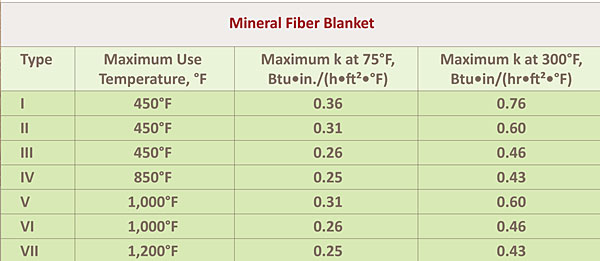
Mineral Fiber Block and
Board
Mineral fiber block and
board insulation is covered in ASTM C612. This standard contains five types classified
by maximum use temperature and thermal conductivity.
Each of these types
is further classified by compressive resistance. Category 1 materials have no requirement
for compressive resistance, while Category 2 materials require a minimum
compressive resistance value. Density is not a performance measure and has been
removed as a requirement in ASTM C612.
The standard also
contains requirements for linear shrinkage, water-vapor sorption,
surface-burning characteristics, odor emission, corrosiveness to steel,
rigidity, and shot (non-fibrous) content. Further, there is an optional
requirement in ASTM C612 for stress corrosion performance if the product is to
be used in contact with austenitic stainless steel. Fibrous glass boards will
generally meet Types I, II, or III. Mineral wool products will generally comply
with the higher temperature requirements for Types IVA, IVB.
These
products are supplied in rigid and semi-rigid board form. Dimensions will vary,
but typical available thicknesses range from 1″ to 4″. The products may be
specified with various factory-applied facings, or may be ordered unfaced.
